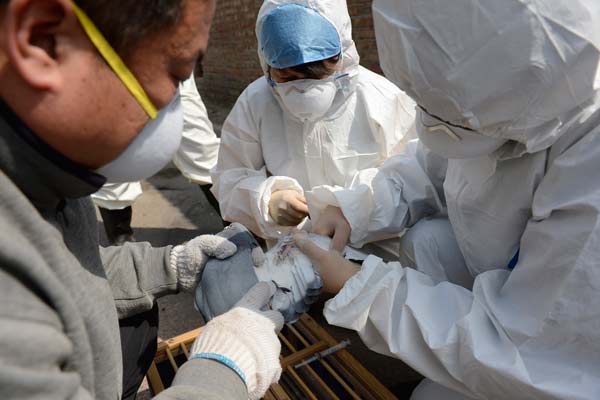..Don'know what it is though
2013-04-17 00:07:56

Killed a total of 410 pig. The analysis showed that: the normal air and water quality standards, initially ruled out H7N9 avian flu.

Killed a total of 122 dogs. The analysis showed that: the normal air and water quality standards, initially ruled out H7N9 avian flu.
Luoyang the Yanshi a village now 410 dead pig 122 dead dogs official involved in the investigation initially ruled out H7N9 avian flu
The samples have been sent to the Ministry of Public Security to verify the incident to the chemical plant to temporarily suspend production farm and the surrounding disinfection
Zhongyuan Reuters (Reporter Chen Zujiang) the morning of April 15, the Yanshi City Mountain of the Town Tuncun sudden pigs, dogs and other domestic animals deaths. After the incident, the local immediately launched the emergency mechanism, the analysis showed that: normal, air and water quality standards, initially ruled out H7N9 avian flu. The sampling of this has been sent to the Ministry of Public Security inspection, incident to all chemical plants temporarily suspend production.
April 15, the Yanshi City Mountain of Town Tuncun a large number of pigs, dogs inexplicable death, According to site statistics, on April 15, a total of 410 death pigs, dogs 122.
After the incident, the first time of the principal leaders of the municipal government has arrived at the scene to see the situation on the ground. The mountain town of livestock expert guidance, select the remote Huanggoushan, take the dug pit, liming, incinerated, buried deep approach, on the death of livestock carcasses concentrated harmless treatment. Meanwhile, the local Animal Husbandry Bureau organization professionals on the farm and the surrounding disinfection. Undergo a medical examination to confirm after the medical expert East Tuncun masses, found no abnormalities.
Local environmental, powered responsible departments, the mountain town of the territory of all the chemical plant on April 15 to take power measures temporarily discontinued all responsible person shall leave Yanshi, to assist the police accident investigation.
In addition, the local hire Country, Henan Luoyang City, livestock, chemicals, health, environmental protection, public security, safety supervision authority experts to form a group of experts, investigation and analysis of the causes of death in domestic animals. Currently, Luoyang City, livestock experts have basically ruled out the animal epidemic and the H7N9 avian influenza. The department of public security, livestock and other extracted the internal organs of the death of livestock, the First Affiliated Hospital of Henan University of Science and Technology and the Ministry of Public Security agencies were sent for examination.
Luoyang Municipal Environmental Protection Bureau experts have comprehensive investigation and investigation and evidence collection near chemicals, footwear and other enterprises; the Mountain Town Tuncun air were detected not detected in ammonia, chlorine, hydrogen chloride, hydrogen fluoride and other harmful gases; on The village drinking water and livestock water testing shows that water quality standards. The public security departments also organized police force early intervention Find clues related criminal investigation.
Currently, animal husbandry, environmental protection, public health, public security, safety supervision and other five departments and expert groups are fully investigating the cause of the incident, the official said progress with the test results to the community and the media for the first time announced. http://news.zynews.com/2013-04/17/content_4564795.htm
..It is understood that, since the morning of the 15th, Luoyang Yanshi City Mountain of Town Tuncun constantly villagers broke the news, said the pigs, dogs and other domestic animals in their own homes bizarre death scene pictures. From the scene pictures you can see dozens of dead dogs dumped at the roadside of the village; pig farms in the homes of villagers, a large number of dead pigs there were corpses. Local villagers said, to keep their homes, several hundreds of head overnight almost all died finished, no death has been dying.http://news.sina.com.cn/c/2013-04-16/234826846770.shtml
Henan the village large number of pigs and dogs death
..It is understood that, since the morning of the 15th, Luoyang Yanshi City Mountain of Town Tuncun constantly villagers broke the news, said the pigs, dogs and other domestic animals in their own homes bizarre death scene pictures. From the scene pictures you can see dozens of dead dogs dumped at the roadside of the village; pig farms in the homes of villagers, a large number of dead pigs there were corpses. Local villagers said, to keep their homes, several hundreds of head overnight almost all died finished, no death has been dying.http://news.sina.com.cn/c/2013-04-16/234826846770.shtml






